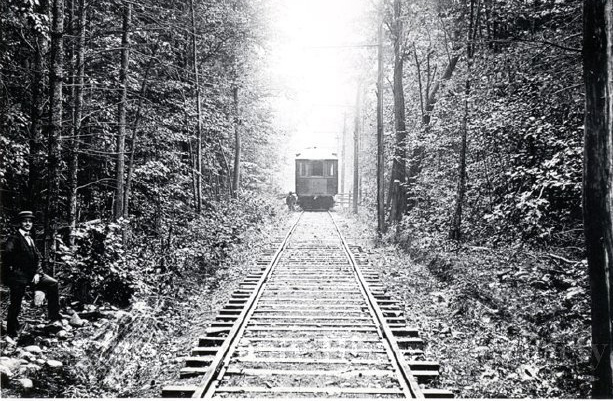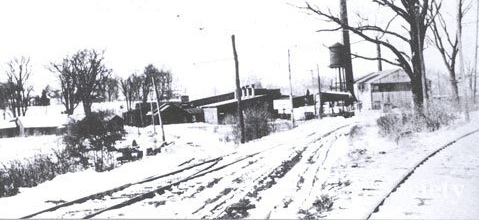Early manufacturing in America drew its energy from the force of falling water. The Kayaderosseras Creek, with its series of rapids, was the industrial heart of Saratoga County in the nineteenth and early twentieth centuries. Prior to changes in land use, the creek carried more water, and local boosters bragged about having “one of the best water powers in the country.”

A trolley traveling though the woods from the Pioneer Mill in Milton to Rock City Falls. The path of the trolley forms part of the trail system of Boyce Park. The indentations caused by the railroad ties are still clearly visible.
About a dozen mills formed a string of mill ponds and factories between Rock City Falls and Ballston Spa. From 1896 to 1929, an electric trolley aided the factories by shuttling raw materials, finished goods, and workers along the banks of the creek.

Pioneer Mill in 1929. Evidence of the trolley line that served the mill, plus parts of the mill dam, are in the Town of Milton Boyce Park.
One of the longest lasting of these water-driven industrial sites was the Pioneer Mill in the Town of Milton, near what is now the Town of Milton Boice Park.
There is some evidence of a mill, perhaps a gristmill, prior to 1800. By 1850, there was a large paper mill at the site.
In 1869, a dispute among the mill’s partners resulted a constable arriving at the mill with a foreclosure notice. He sent home the crew, which among other things, tended the boilers and steam engines. That night, a fire destroyed the mill. Ballston Spa’s leading industrialist, George West, had learned the paper business as an employee of the mill. In 1870, he bought the ruins and rebuilt the mill, using it to produce paper for his paper bag factory, still standing, on Milton Ave. in Ballston Spa. Pioneer Mill continued producing paper until the trolley ceased operation in 1929. It was then torn down.
According to a report produced by a trade association in 1879, Saratoga County had 13 paper mills, seven of which were along the Kayaderosseras. It was claimed that these mills produced more manila paper (the kind used in paper bags) then was being produced by any country in Europe.